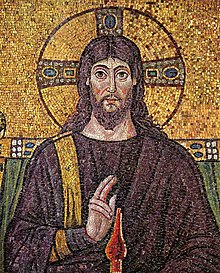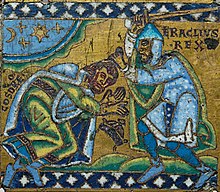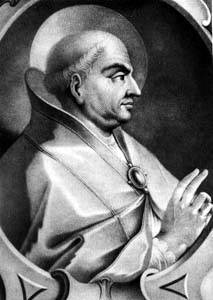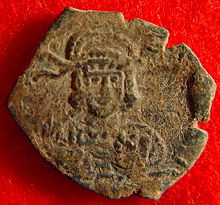Ο Μονοθελητισμός ήταν χριστιανικό δόγμα, το οποίο αναπτύχθηκε τον 7ο αιώνα και πρέσβευε ότι ο Χριστός είχε δύο φύσεις αλλά μία θέληση.
Ιστορία
Ο Μονοθελητισμός εμφανίστηκε ως συνέχεια του Μονοφυσιτισμού, όταν ο Αυτοκράτορας Ηράκλειος εξέδωσε το διάταγμα γνωστό ως "Έκθεσις" το 638 προκειμένου να γεφυρώσει το χάσμα μεταξύ μονοφυσιτών υπηκόων στις περιοχές της Αιγύπτου, Παλαιστίνης και Συρίας και της υπόλοιπης ορθόδοξης Εκκλησίας, καθώς κατανοούσε ότι η δογματική και εθνολογική διαφορά, η μεγάλη απόσταση από την Κωνσταντινούπολη και οι συνεχείς επιθέσεις από Πέρσες και Άραβες αποξένωναν τους πληθυσμούς αυτούς από την αυτοκρατορία και καθιστούσαν εύκολη την απώλεια των εν λόγω περιοχών, όπως και τελικά έγινε κατά την αραβική κατάκτηση. Σύμφωνα με αυτό το σχέδιο, οι μονοφυσίτες θα δέχονταν ότι στον Χριστό υπάρχουν δύο φύσεις μετά την ένωση θείας και ανθρωπίνης φύσεως, και οι Ορθόδοξοι θα δέχονταν ότι στον Χριστό υπάρχει μία θέληση και ενέργεια, μετά την ένωση των δύο φύσεων.
Παρά την προσπάθειά του να επιβάλει το νέο δόγμα, ο Μονοθελητισμός δεν επικράτησε, αλλά πολεμήθηκε από τον Πάπα Μαρτίνο Α΄, τον Μάξιμο τον Ομολογητή και άλλους, και αφού πρώτα απαγορεύτηκε μέσω του διατάγματος του " Τύπου" που εξέδωσε ο Κώνστας Β' το 648 η συζήτηση περί μιας ή δύο θελήσεων ή ενεργειών του Χριστού, τελικά καταδικάστηκε από την ΣΤ΄ Οικουμενική Σύνοδο, η οποία απεφάνθη ότι αφού στην υπόσταση του Χριστού υπάρχουν δύο φύσεις, η θεία και η ανθρωπίνη, υπάρχουν και δύο φυσικές θελήσεις και δύο φυσικές ενέργειες, η θεία και η ανθρωπίνη, που ενεργούσαν «αδιαιρέτως, ατρέπτως, αμερίστως, ασυγχύτως», χωρίς να επικρατεί αντιπαλότητα μεταξύ τους.Πρότυπο:Ι.Ε. Καραγιαννόπουλου, η Ιστορία του Βυζαντινού Κράτους, τόμος β
wikipedia Ελληνικά
Monothelitism or Monotheletism (from Greek μονοθελητισμός "doctrine of one will") is a particular teaching about how the divine and human relate in the person of Jesus, known as a Christological doctrine, that formally emerged in Armenia and Syria in 629.[1]Specifically, monothelitism teaches that Jesus Christ had two natures but only one will. This is contrary to the more contemporarily accepted Christology that Jesus Christ has two wills (human and divine) corresponding to his two natures (dyothelitism). Monothelitism is a development of the miaphysite or monophysite position in the Christological debates. It enjoyed considerable popularity in the early Middle Ages, even garnering patriarchal and papal support in the 7th century, before being rejected and denounced asheretical.
Contents[show] |
[edit]Background
During the 5th century, some regions of theChristian Church were thrown into confusion because of the debates that erupted over the nature of Jesus Christ. Although the Church had already determined that Christ was the Son of God, just what his exact nature was remained open to debate. The Church had declared the notion that Jesus was not fully divine heretical in the 4th century (see First Council of Nicaea), during the debates over Arianism and had declared that he was God the Son become human. However, as he was both God and man, there now emerged a dispute over exactly how the human and divine natures of Christ actually existed within the person of Christ.
The Christological definition of Chalcedon, as accepted by the Eastern Orthodox, Catholic, Anglican, and Lutheranchurches, is that Christ remains in two distinct natures, yet these two natures come together within His one hypostasis. This position was opposed by the Monophysites who held that Christ possessed one nature only. The term Monophysitism of which Eutychianism is one type, held that the human and divine natures of Christ were fused into one new single (mono) nature. As described by Eutyches, his human nature was "dissolved like a drop of honey in the sea", and therefore his nature was really divine.[2] This is distinct from Miaphysitism that states, after the union, Christ is in one theanthropic (human-divine) nature, which is generated from the union of two natures, the two being united without separation, without confusion, and without alteration, and with each having a particularity. Miaphysitism is currently the christological doctrine of theOriental Orthodox churches.[citation needed]
Nevertheless, the resultant debates led the Chalcedonians to accuse the Non-Chalcedonians of teaching Christ's humanity to be of a different kind from our own. Meanwhile, the Non-Chalcedonians accused the Chalcedonians of espousing a form of Nestorianism, a rejected doctrine that held that Jesus Christ was two distinct subsistences.
This internal division was dangerous for the Byzantine Empire, which was under constant threat from external enemies, especially as many of the areas most likely to be lost to the empire were the regions that were in favour of Monophysitism, and who considered the religious hierarchy at Constantinople to be heretics only interested in crushing their faith.[3] In these provinces, the Non-Chalcedonians were far more numerous than the Chalcedonians. In Egyptfor instance, some 30,000 Greeks of Chalcedonian persuasion were ranged against some five million CopticNon-Chalcedonians.[4] Meanwhile, Syria and Mesopotamiawere divided between Nestorianism and Jacobitism, while the religion of Armenia was wholly Cyrilline Non-Chalcedonian. Consequently the Monothelite teaching emerged as a compromise position. The Byzantine emperor Heraclius tried to unite all of the various factions within the Empire with this new formula that was more inclusive and more elastic.
This approach was needed to win over the Non-Chalcedonians, since they, already believing Christ possessed a single nature, necessarily also believed that he held a single will. But it was unclear whether the Chalcedonians should believe in Christ’s human and divine energy and/or will as well as his human and divine nature, because the ecumenical councils had made no ruling on this subject. A ruling in favour of this new doctrine would provide common ground for the Non-Chalcedonians and the Chalcedonians to come together, as the Non-Chalcedonians could agree that Jesus had two natures if he only had one will, and some Chalcedonians could agree that Jesus had one will if he had two natures.[5]
[edit]First attempt: Doctrine of one energy
PatriarchSergius I of Constantinoplewas the driving force behind this doctrine, with the full blessing of the Emperor Heraclius.[6]Coming to the imperial throne in 610, the patriarch had long since converted the emperor to the new doctrine, as by 622, Heraclius had communicated with Bishop Paul of Armenia where the emperor asserted that the energy, or the active force, of Christ was single. This doctrine of Monoenergism was the precursor of Monotheletism.[5]
Heraclius’ interest at the time was focused on Armenia, and it was probably at this time that the emperor decided to use Monothelitism as a political weapon and reconcile the Non-Chalcedonian Church of Armenia with the Imperial Church.[5] To help bring this about, a synod was held in 622 at Theodosiopolis, called the Synod of Garin where Monoenergism was discussed. Over the next few years Heraclius was preoccupied with his prosecution of the war against the Sassanids, but by 626 he had issued a decree to Arcadius, Bishop of Cyprus, requesting that he teach the doctrine of "one hegumenic energy". By all accounts this was met with notable success, particularly as there was a large colony of Armenians on the island at that time,[1] and this encouraged Heraclius to attempt to seek a wider approval of his compromise. In 626, he asked Patriarch Sergius to approach Cyrus, Bishop of Phasis, to secure his cooperation.
With the successful conclusion to the Persian war, Heraclius could devote more time to promoting his compromise, which was now more urgent due to the administration of the recovered Monophysite provinces of Syria and Egypt. So in 629, a meeting took place between the emperor and Athanasius the Jacobite at Hierapolis. An agreement was struck whereby the Jacobites were to return to the Imperial Church on the basis of the single energy doctrine, and Athanasius was to be made Patriarch of Antioch. Then in 630, Bishop Cyrus was made Patriarch of Alexandria, and he soon won over another Non-Chalcedonian group. Very soon three of the five Patriarchates – Constantinople, Antioch and Alexandria – were teaching about Christ’s "one theandric energy".[1]
But not everyone was convinced, in particular a monk ofPalestine named Sophronius, who believed there was something unsound in the doctrine, became the champion of Dyothelitism – the doctrine of the two wills of Christ. He was concerned that for the sake of ecclesiastical unity, doctrinal expressions were being compromised.[7] For the first few years Patriarch Sergius of Constantinople managed to keep him silent, but when Sophronius was appointed Patriarch of Jerusalem in 634, he used his newfound position of authority to challenge the validity of the doctrine of Monoenergism.
Determined to prevent this formidable challenge to his Christological compromise, Sergius wrote to the Patriarch of the West, Pope Honorius I, at Rome, asking him to endorse a position that Church unity should not be endangered by having any discussions or disputes over Christ’s possessing one energy or two. Pope Honorius’ reply in 635 not only endorsed this view that all discussions should cease, but he also agreed with the doctrine of Monoenergism.[7] Although Honorius himself agreed with Sergius' formula, he did not define it as dogma using his papal authority (ex cathedra).[8] In the meantime theepistola synodica of Sophronius appeared, the outcome of the Synod of Cyprus, and this attempted to show that the new doctrine was inconsistent with orthodoxy. He declared that it was nothing more than a bastardized form of Monophysitism, and consequently it went against the hard fought achievements at Chalcedon. Suddenly, support for the doctrine began to subside and soon former supporters were busy finding flaws and inconsistencies in the proposal.[9] Soon, Sergius and Heraclius abandoned it as a doctrine.
[edit]Second attempt: Doctrine of one will
Main article: Ecthesis
Yet Sergius and the emperor refused to give up. Three years later the patriarch came up with a slightly modified formula, which Heraclius released as the Ecthesis in 638. This edict was considered to be the official response to Sophronius' letter.[10] It forbade all mention of Christ possessing one or two energies; instead, it now proclaimed that Christ, while possessing two natures, had but a singlewill. This approach seemed to be a more acceptable compromise, and once again it secured widespread support throughout the East. Sophronius had died before the release of the new doctrine, and his replacement as Patriarch of Jerusalem approved the modified formula. Patriarch Sergius died by the end of 638, and his replacement Pyrrhus was also a devoted Monothelite and a close friend of Heraclius. The two remaining patriarchs in the East also gave their approval to the doctrine now referred to as Monothelitism, and so it looked as if Heraclius would finally heal the divisions in the imperial church.[11]
Unfortunately he had not counted on the popes at Rome. During that same year of 638, Pope Honorius I too had died. His successor Pope Severinus condemned theEcthesis outright, and so was forbidden his seat until 640. His successor Pope John IV also rejected the doctrine completely, leading to a major schism between the eastern and western halves of the Chalcedonian Church. When news reached Heraclius of the Pope’s condemnation, he was already old and ill, and the news only hastened his death, declaring with his dying breath that the controversy was all due to Sergius, and that the patriarch had pressured him to give his unwilling approval to theEcthesis.[12]
[edit]Conflict with Rome
This state of schism remained for the next few years. The death of Heraclius in 641 had thrown the political situation in Constantinople into chaos, and his young grandsonConstans IIeventually succeeded him. Meanwhile in Africa, a monk named Maximus the Confessorcarried on a furious campaign against Monothelitism, and in 646 he convinced the African councils to draw up a manifesto against the doctrine. This they forwarded to the new pope,Theodore I, who in turn wrote to Patriarch Paul II of Constantinople, outlining the heretical nature of the doctrine. Paul, another devoted Monothelite, replied in a letter directing the pope to adhere to the doctrine of one will. Theodore in turn excommunicated the patriarch in 649, declaring Paul a heretic.[13]
Constans II was a young man of seventeen, and he was supremely indifferent to the religious debates convulsing the Church.[14] However, he was certainly concerned about the effect all these arcane debates were having on theRoman Empire, and so he issued an imperial edict called the Type of Constans. This edict made it illegal to discuss in any manner the topic of Christ possessing either one or two wills, or one or two energies. He declared that the whole controversy was to be forgotten – "the scheme which existed before the strife arose shall be maintained, as it would have been if no such disputation had arisen."[14] He would soon discover that it was far too late to turn the clock back.
In Rome and the West, the opposition to Monothelitism was reaching fever pitch, and the Type of Constans did nothing to defuse the situation; indeed it made it worse by implying that either doctrine was as good as the other.[14] Theodore planned the Lateran Council of 649 to condemn theEcthesis, but died before he could convene it, which his successor, Pope Martin I, did. Not only did the Council condemn the Ecthesis, it also condemned the Type as well. After the synod, Pope Martin wrote to Constans, informing the emperor of its conclusions and requiring him to condemn both the Monothelite doctrine and his own Type. Unfortunately, Constans was not the sort of emperor to take such a rebuke of imperial authority lightly.[15]
Even while the Lateran Synod was sitting, Olympius arrived as the new exarch of Ravenna, with instructions to ensure that the type was followed in Italy, and to use whatever means necessary to ensure that the Pope adhered to it.[16]He was unable to complete his mission and soon died, but his successor Theodore I Calliopas seized Pope Martin and abducted him to Constantinople. Here he was imprisoned and tortured before being condemned for breaking the imperial commands and was banished before dying from his treatment at the hands of the emperor.[17]
The emperor continued to persecute any who spoke out against Monothelitism, including Maximus the Confessor and a number of his disciples – Maximus lost his tongue and his right hand in an effort to have him recant.[18]Nevertheless, his brutality did have an effect, with the patriarchs, including the popes, remaining silent throughout the remainder of his reign.
[edit]Condemnation of Monothelitism
See also: Third Council of Constantinople
With Constans' death in 668, the throne passed to his sonConstantine IV.Pope Vitalian, who had hosted the visit of Constans II to Rome in 663, almost immediately declared himself in favor of the doctrine of the two wills of Christ. In response Patriarch Theodore I of Constantinople and Macarius, Patriarch of Antioch, both pressed Constantine to take some measures against the pope. Constantine, however, decided to let the Monothelite question be decided entirely by a church council.[19]
He asked if the pope (by this stage Pope Agatho) would be willing to send delegates to an ecumenical council to be held at Constantinople to finally put an end to this question. Agatho agreed, but first held a preliminary synod at Rome 680 in order to obtain the opinion of the western theologians. Other synods were also held at Milan and at the Council of Hatfield in 680, convoked by Archbishop Theodore of Canterbury.[20] All the western synods condemned Monothelitism, and a report of the Roman synod’s acts was sent to Constantinople, along with the western delegates to the council.
This council met from 680 to 681. Apart from the Roman representatives, it also hosted representatives from the Patriarchs of Alexandria and Jerusalem, while the Patriarchs of Constantinople and Antioch were present in person. It almost unanimously, with the exception of two individuals, condemned the Monothelite doctrine as one that diminished the fullness of Christ’s humanity, and asserted that Dyothelitism was the true doctrine, with Christ possessing "two natural wills and two natural energies, without division, alteration, separation or confusion."[21] It also anathematized the chief representatives of the discredited doctrine, including Pope Honorius. The churches condemned at Constantinople included the Oriental Orthodox churches and the Maronite church, although the Oriental Orthodox deny that they ever held the Monothelite view (describing their own Christology asMiaphysite), and the Maronites accept the Chalcedonian formula being in communion with the Roman Catholic Church. This brought to an end the controversy over Monothelitism.
[edit]Controversy over Pope Honorius I
A side issue over the Monotheletism debates eventually arose around the actions and condemnation of Pope Honorius I during the discussions concerning Papal Infallibility. Firstly, it is plain that Pope Honorius endorsed the notion of Monoenergism as defined by Patriarch Sergius, as written in his reply to the Patriarch. His consent has led to much debate, but in the view of historians such as John Bagnell Bury, it is clear that Honorius, with a traditional Latin dislike for dialectics, did not fully comprehend the issues.[7] It seemed to Honorius to be a matter of grammar rather than theology. Though he used the expression "one will", it is apparent that he was no Monothelete, for he placed "one energy" and "two energies" on exactly the same footing. Further, in his second letter to Sergius, what he wrote was by and large orthodox.[7]
Secondly, the Third Council of Constantinople did indeed anathematize the Pope as a heretic. The Acts of the Council clearly state: "And with these we define that there shall be expelled from the holy Church of God and anathematized Honorius who was some time Pope of Old Rome, because of what we found written by him to Sergius, that in all respects he followed his view and confirmed his impious doctrines" (13th Session) and "To Honorius, the heretic, anathema!" (16th Session). However, in subsequent documents, in particular the letter of confirmation from the Council to Pope Leo II, it becomes evident that the intent of the council was not to criticize Pope Honorius for his error of belief, but rather his "imprudent economy of silence".[7]The Council's letter of confirmation clearly states: "We anathematize the inventors of the new error, that is, Theodore, Sergius, ...and also Honorius, who did not attempt to sanctify this Apostolic Church with the teaching of Apostolic tradition, but by profane treachery permitted its purity to be polluted."[22]
Monotheletismus
Der Monotheletismus (von griechisch monos – einzig, und thelô – wollen) ist einechristologische Lehre, derzufolge Christus zwei Naturen – eine göttliche und eine menschliche –, aber nur einen Willen (Ziel, Zielausrichtung) besitzt. Christus habe zwar eine eigene menschliche Natur, sein Wille sei jedoch von Gott vollständig diktiert.
Er wurde Anfang des 7. Jahrhunderts unter dem oströmischen Kaiser Herakleios entwickelt, um die auf dem Konzil von Chalcedon festgelegte Zweinaturenlehre Christi mit dermonophysitischen Lehre auszusöhnen. Die Monophysiten sollten auf diese Weise wieder in die Reichskirche eingegliedert werden, aus der sie zuvor exkommuniziert worden waren.
Trotz der Sympathien des Kaisers und des Papstes Honorius I. wurde der Monotheletismus sowohl von der Ost- als auch von der Westkirche letztlich zurückgewiesen und selbst von den Monophysiten nicht akzeptiert. Maximus der Bekenner wandte sich besonders intensiv gegen diese Lehre. Auf dem 3. Konzil von Konstantinopel im Jahr 680 wurde die Lehre als Häresieverurteilt und die bis heute bestehende Doktrin ausgegeben, dass Christus zu jeder seiner beiden Naturen einen Willen besitzt und der menschliche Wille dem göttlichen Willen untergeordnet ist.
Im Byzantinischen Reich erfuhr der Monotheletismus unter Kaiser Philippikos Bardanes (711 - 713) eine kurze Wiederbelebung, was mit eine Ursache für den baldigen Sturz dieses Kaisers war.
wikipedia Deutsch



















0 σχόλια:
Δημοσίευση σχολίου